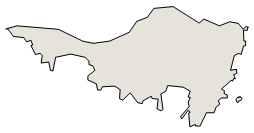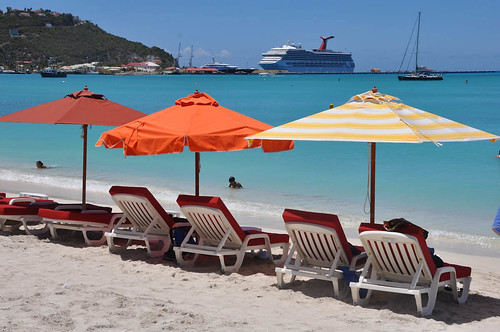.
Saint Martin


Saint Martin
Saint Martin (Central America and Caribbean)
Introduction ::Saint Martin
Background:
Although sighted by Christopher COLUMBUS in 1493 and claimed for Spain, it was the Dutch who occupied the island in 1631 and set about exploiting its salt deposits. The Spanish retook the island in 1633, but continued to be harassed by the Dutch. The Spanish finally relinquished Saint Martin to the French and Dutch, who divided it amongst themselves in 1648. Friction between the two sides caused the border to frequently fluctuate over the next two centuries, with the French eventually holding the greater portion of the island (about 57%). The cultivation of sugar cane introduced slavery to the island in the late 18th century; the practice was not abolished until 1848. The island became a free port in 1939; the tourism industry was dramatically expanded during the 1970s and 1980s. In 2003, the populace of Saint Martin voted to secede from Guadeloupe and in 2007, the northern portion of the island became a French overseas collectivity.
Geography ::Saint Martin
Location:
island 300 km southeast of Puerto Rico
Geographic coordinates:
18 05 N, 63 57 W
Map references:
Central America and the Caribbean
Area:
total: 54.4 sq km country comparison to the world: 230 land: 54.4 sq km
water: NEGL
Area - comparative:
more than one-third the size of Washington, DC
Land boundaries:
total: 15 km
border countries: Sint Maarten 15 km
Coastline:
58.9 km (for entire island)
Climate:
temperature averages 80-85 degrees all year long; low humidity, gentle trade winds, brief, intense rain showers; July-November is the hurricane season
Elevation extremes:
lowest point: Caribbean Ocean 0 m
highest point: Pic du Paradis 424 m
Natural resources:
salt
Natural hazards:
subject to hurricanes from July to November
Environment - current issues:
fresh water supply is dependent on desalinization of sea water
Geography - note:
the island of Saint Martin is the smallest landmass in the world shared by two independent states, the French territory of Saint Martin and the Dutch territory of Sint Maarten
People ::Saint Martin
Population:
30,235 (July 2010 est.) country comparison to the world: 214
Age structure:
0-14 years: 27% (male 3,991/female 4,048)
15-64 years: 67.5% (male 9,596/female 10,532)
65 years and over: 5.5% (male 742/female 911) (2010 est.)
Median age:
total: 30.8 years
male: 29.7 years
female: 31.6 years (2010 est.)
Sex ratio:
at birth: 1.04 male(s)/female
under 15 years: 0.99 male(s)/female
15-64 years: 0.91 male(s)/female
65 years and over: 0.82 male(s)/female
total population: 0.93 male(s)/female (2010 est.)
Ethnic groups:
creole (mulatto), black, Guadeloupe Mestizo (French-East Asia), white, East Indian
Religions:
Roman Catholic, Jehovah's Witness, Protestant, Hindu
Languages:
French (official language), English, Dutch, French Patois, Spanish,
Papiamento (dialect of Netherlands Antilles)
Government ::Saint Martin
Country name:
conventional long form: Overseas Collectivity of Saint Martin
conventional short form: Saint Martin
local long form: Collectivity d'outre mer de Saint-Martin
local short form: Saint-Martin
Dependency status:
overseas collectivity of France
Capital:
name: Marigot
geographical coordinates: 18 04 N, 63 05 W
time difference: UTC-4 (1 hour behind Washington, DC, during Standard Time)
daylight savings: +1 hour
Independence:
none (overseas collectivity of France)
National holiday:
Bastille Day, 14 July (1789); note - local holiday is Schoalcher Day
(Slavery Abolition Day) 12 July (1848)
Constitution:
4 October 1958 (French Constitution)
Legal system:
the laws of France where applicable apply
Suffrage:
18 years of age, universal
Executive branch:
chief of state: President Nicolas SARKOZY (since 16 May 2007), represented by Prefect Dominique LACROIX (since 21 March 2007)
head of government: President of the Territorial Council Frantz GUMBS (since 5 May 2009)
cabinet: Executive Council; note - there is also an advisory economic, social, and cultural council (For more information visit the World Leaders website ) election: French president elected by popular vote to a five-year term; prefect appointed by the French president on the advice of the French Ministry of Interior; president of the Territorial Council elected by the members of the Council for a five-year term
election results: Frantz GUMBS elected president by the Territorial Council on 7 August 2008 but election was declared invalid on 10 April 2009
Legislative branch:
unicameral Territorial Council (23 seats; members are elected by popular vote to serve five-year terms)
elections: last held on 1 and 8 July 2007 (next to be held in July 2012)
election results: percent of seats by party - UPP 49%, RRR 42.2%, Reussir Saint-Martin 8.9%; seats by party - UPP 16, RRR 6, Reussir Saint-Martin 1
note: Saint Martin elects one member to the French Senate; election last held on 21 September 2008 (next to be held in September 2014); results - percent of vote by party - NA; seats by party - UMP 1
Political parties and leaders:
Union Pour le Progres or UPP [Louis-Constant FLEMING]; Rassemblement
Responsabilite Reussite or RRR [Alain RICHARDSON]; Reussir
Saint-Martin [Jean-Luc HAMLET]
Political pressure groups and leaders:
NA
International organization participation:
UPU
Diplomatic representation in the US:
none (overseas collectivity of France)
Diplomatic representation from the US:
none (overseas collectivity of France)
Flag description:
the flag of France is used
National anthem:
name: "O Sweet Saint Martin's Land"
lyrics/music: Gerard KEMPS
note: the song, written in 1958, is used as an unofficial anthem for the entire island (both French and Dutch sides); as a collectivity of France, in addition to the local anthem, "La Marseillaise" remains official on the French side (see France); as a constituent part of the Kingdom of the Netherlands, in addition to the local anthem, "Het Wilhelmus" remains official on the Dutch side (see Netherlands)
Economy ::Saint Martin
Economy - overview:
The economy of Saint Martin centers around tourism with 85% of the labor force engaged in this sector. Over one million visitors come to the island each year with most arriving through the Princess Juliana International Airport in Sint Maarten. No significant agriculture and limited local fishing means that almost all food must be imported. Energy resources and manufactured goods are also imported, primarily from Mexico and the United States. Saint Martin is reported to have the highest per capita income in the Caribbean.
GDP - composition by sector:
agriculture: 1%
industry: 15%
services: 84% (2000)
Labor force - by occupation:
85% directly or indirectly employed in tourist industry
Industries:
tourism, light industry and manufacturing, heavy industry
Imports - commodities:
crude petroleum, food, manufactured items
Exchange rates:
euros (EUR) per US dollar - 0.7715 (2010), 0.7338 (2009), 0.6827 (2008), 0.7345 (2007), 0.7964 (2006)
Communications ::Saint Martin
Telephone system:
general assessment: fully integrated access
domestic: direct dial capability with both fixed and wireless systems
international: country code - 590; undersea fiber-optic cable provides voice and data connectivity to Puerto Rico and Guadeloupe
Broadcast media:
1 local TV station; receives television broadcasts from the Netherlands Antilles; access to about 20 radio stations, including RFO Guadeloupe radio broadcasts via repeater (2008)
Internet country code:
.mf; note - .gp, the internet country code for Guadeloupe, and .fr, the internet country code for France, might also be encountered
Transportation ::Saint Martin
Airports:
1 (2010) country comparison to the world: 224
Airports - with paved runways:
total: 1
914 to 1,523 m: 1 (2010)
Transportation - note:
nearest airport for international flights is Princess Juliana International Airport (SXM) located in Sint Maarten
Military ::Saint Martin
Manpower fit for military service:
males age 16-49: 6,391
females age 16-49: 6,947 (2010 est.)
Manpower reaching militarily significant age annually:
male: 172
female: 165 (2010 est.)
Military - note:
defense is the responsibility of France


